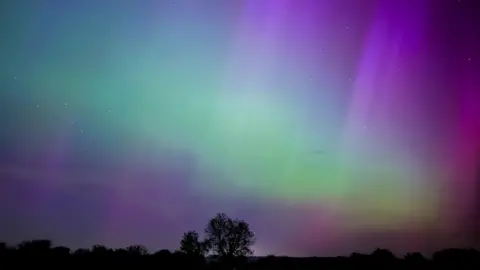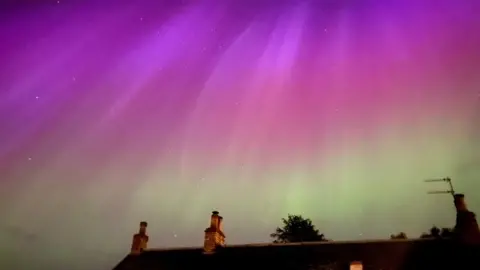How to see the Northern Lights in the UK on Saturday night
 BBC Weather Watchers/StormChaserLiam
BBC Weather Watchers/StormChaserLiamIf you woke up on Saturday morning well rested but filled with regret over missing the Northern Lights - don't worry. They're set to return tonight.
On Friday night, the lights dazzled the country, and the internet was awash with photos of bright pinks, purples and greens splashed across the night sky.
Here is everything you need to know about how to catch them on Saturday night.
Where in the UK can I see the Northern Lights on Saturday?
Just as on Friday night, the Northern Lights are set to light up the skies all across the UK.
That means you have a chance to see it no matter where you are, as long as the skies are clear (which is looking likely).
On Friday, we saw pictures from Inverness to Kent, and Omagh to Anglesey to Norwich, so it truly is a nationwide spectacle.
Ordinarily, somewhere away from light pollution with a clear view of the night sky has the best opportunity to see the lights, but based on Friday night, that didn't matter.
For Saturday night, the Met Office says there's a good chance of sightings across Scotland, Northern Ireland and parts of northern England and Wales in particular.
What time will they be brightest?
Aurora activity is expected again across the UK and while the geomagnetic storm is still expected to be in the 'strong' category, early indications are that it may not reach the 'extreme' of last night with activity declining.
Weather conditions are ideal with clear skies but it needs to be dark, so you'll need to wait until at least 22:30 BST.
At this time of year, when nights are shorter, 23:30 into the early hours of the morning is when the night is darkest.
The activity of the lights itself is more unpredictable, the Met Office says, so expect it to ebb and flow with different colours in different places at different times.
Coincidentally, if you are tuning into Eurovision tonight, the winner is due to be crowned just before the best time to see the lights (even better if the contest runs over time, as it often does, and you peek outside later in the night).
How do I get the best photo of them?
On Friday night, our BBC Weather Watchers captured the magic with more than 3,000 photographs sent into us between 21:00 and 1:00 on Saturday morning.
Given the lights are not expected to be as bright as they were on Friday, you may need to employ some camera tricks to get the most out of your photo if you are heading out on Saturday night.
 BBC Weather Watchers/Lara
BBC Weather Watchers/LaraAmateur photographer Anne Wilkie was among those who captured the lights on her iPhone on Friday night.
Her tips for getting the best photo include:
- Switch off the flash
- Set the camera to night mode, and adjust the slider to three to five seconds
- Keep the camera as steady as possible or use a tripod
"I found that the camera is very sensitive and picks up the colours so much more than the naked eye, so, if you think you see light in the sky, point the camera in the direction and the pinks, greens and purples should show on the screen, if you're lucky," Ms Wilkie said.
All phone users will want to play with the exposure to capture the best of the lights – most phones will bring up this option by tapping the screen when in the camera app.
Some more recent phone models may have even more advanced camera settings, which allow for shutter speed and the length of exposure to be adjusted.
Setting a long exposure time can capture the dance of the lights, but you will have to keep the phone still to avoid blurring.
What are the Northern Lights?
The Northern Lights are caused by atoms with electric charges, called charged particles.
The lights appear when these charged particles are shot out from the sun and hit gases in the Earth's atmosphere.
In this instance, the Sun is experiencing an extreme geomagnetic storm, which is sending out solar winds with those particles into the solar system.
We see different colours in the sky when the various gases in the Earth's atmosphere are energised by the charged particles.
The two most common gases in the Earth's atmosphere are oxygen and nitrogen. Oxygen atoms glow green - the colour most often seen in the Northern Lights, while nitrogen atoms emit purple, blue and pink.
Why are the lights shining for two nights in a row?
The last time we had an extreme geomagnetic storm hit Earth was in 2003, so Friday's event was rare. We are much more used to seeing the Northern Lights limited to northern parts of the UK.
There have been more occasions in the last year or so where we have seen a weak showing of the aurora in southern parts of the UK.
This is because in the Sun's 11 year solar cycle, we are approaching the 'solar maximum', where there are naturally more sunspots on the Sun's surface.
Sunspots are like huge volcanos erupting charged particles in Coronal Mass Ejections (CMEs). With more of them at the moment, there is a greater chance of more frequent and strong auroral activity.
It is also worth pointing out that because we can forecast these events better and with most of us having a smart phone able to capture the bright lights of the aurora, there has been an increase in sightings over the last decade or two.
